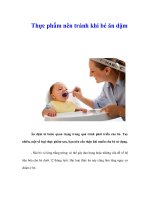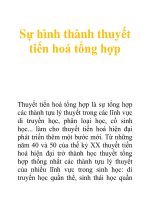Tài liệu Pilot surface water treatment plant Hoa An, Vietnam pdf
Bạn đang xem bản rút gọn của tài liệu. Xem và tải ngay bản đầy đủ của tài liệu tại đây (1.26 MB, 41 trang )
Funded by the
Federal Ministry of Research and Education, Germany
(Project ID 02WD0621)
Part Project 2:
Improvement of the Rural Water Supply
Pilot Surface Water Treatment Plant
Hoa An, Vietnam
Manual & Documentation
(Version from the 27.09.2007)
SANSED II
Part Project 2: Water Supply
II
The Pilot Surface Water Treatment Plant Hoa An was developed within the
Project – Part Project 2: Improvement of the Rural Water Supply
funded by the
German Federal Ministry of Research and Education (BMBF)
Project ID 02WD0621
Authors
Dipl.-Ing. Thomas Nuber, Environmental Engineering and Ecology, Ruhr-University Bo-
chum, Germany
Frank Benstoem, Environmental Engineering and Ecology, Ruhr-University Bochum, Ger-
many
Dipl.-Geoökol. Thilo Herrmann, Ingenieurbüro Technische Hydrologie, Bayreuth, Germany
M.Eng. Le Anh Tuan, Department of Environmental and Water Resources Engineering, Col-
lege of Technology, Can Tho University, Vietnam
Pilot Surface Water Treatment Plant
Hoa An, Vietnam
MANUAL & DOCUMENTATION
III
Contents
1. Introduction...................................................................................................................1
1.1. Idea of the pilot surface water treatment plant..........................................................1
1.2. Purpose of the manual .............................................................................................1
1.3. Contact .....................................................................................................................1
2. Treatment Concept.......................................................................................................3
2.1. Treatment Capacity ..................................................................................................4
2.2. Water Catchment......................................................................................................4
2.3. Flocculation ..............................................................................................................4
2.4. Sedimentation...........................................................................................................5
2.5. Rapid Sand Filtration ................................................................................................5
2.6. Slow Sand Filtration..................................................................................................6
2.7. Disinfection UV-Lamp...............................................................................................6
2.8. Disinfection with Chlorine .........................................................................................6
3. Dimensioning................................................................................................................7
3.1. Sedimentation Tanks................................................................................................7
3.1.1. Sedimenation Area ...............................................................................................7
3.1.2. Flow Rate..............................................................................................................7
3.1.3. Flow Velocity.........................................................................................................7
3.1.4. Retention time.......................................................................................................8
3.2. Tube Reactors ..........................................................................................................8
3.2.1. Equations for the dimensioning of the Tube Reactors..........................................8
3.2.2. Dimensioning of the Micro Flocculation Reactor R-1a and R-2a:.........................9
3.2.3. Dimensioning of the Macro Flocculation Reactor R-1b and R-2b.......................10
3.3. Rapid-Sand-Filter ...................................................................................................11
3.3.1. Diameter of the filter ...........................................................................................11
3.3.2. Filter Height ........................................................................................................11
4. Electrical Set-up .........................................................................................................12
4.1. Operating Mode......................................................................................................12
5. How to get the treatment plant started .......................................................................14
SANSED II
Part Project 2: Water Supply
IV
6. How to shut down the treatment plant ........................................................................18
7. Troubleshooting..........................................................................................................18
8. Maintenance...............................................................................................................18
9. Literature ....................................................................................................................22
10. Appendix.....................................................................................................................23
Pilot Surface Water Treatment Plant
Hoa An, Vietnam
MANUAL & DOCUMENTATION
V
Symbols, Abbreviations, Dimensions
PSWTP Pilot Surface Water Treatment Plant
A
²][m
Area
d
][m
Diameter
G
][
1−
s
Velocity gradient
l
][m
Length
Q
]/[
3
sm
Flow rate
Re
][−
Reynolds coefficient
t
][s
Time
v
]/[
sm
Flow velocity
λ
][−
Loss coefficient
υ
]/²[
sm
Kinematic viscosity
SANSED II
Part Project 2: Water Supply
VI
Figures
Fig. 1: Process Overview .........................................................................................................3
Fig. 2: Process Flow Chart 1/3 ...............................................................................................24
Fig. 3: Process Flow Chart 2/3 .............................................................................................25
Fig. 4: Process Flow Chart 3/3 ...............................................................................................26
Fig. 5: Plan View ....................................................................................................................27
Fig. 6: Sedimentation Tanks...................................................................................................28
Fig. 7: Electrical Installation....................................................................................................29
Tables
Tab. 1: Electrical components................................................................................................12
Tab. 2: Parts List ....................................................................................................................30
Pilot Surface Water Treatment Plant
Hoa An, Vietnam
MANUAL & DOCUMENTATION
1
1. Introduction
1.1. Idea of the pilot surface water treatment plant
At Hoa An research station - belonging to Can Tho University - a student dormitory and other
research facilities are under construction. The existing ground water supply will not meet the
prospective fresh water demands of about 300 people in the nearest future.
In the framework of the SANSED-Project a pilot surface water treatment plant (PSWTP) Is
being constructed in Hoa An. The PSWTP should be used for scientific purposes but it
should also be able to supply the research station with water.
For the design of the pilot surface water treatment plant the following conditions had to be
reached:
• treatment steps are easy to understand
• treatment plant can be rebuilt with parts available in Vietnam
• low costs and low maintenance but efficient
• robust
Besides standard treatment components (e.g. sedimentation tanks, disinfection) tube reac-
tors where the flocculation takes place and a slow sand filter are applied. The tube reactors
provide a reliable formation of settleable flakes even under sub-optimal operating conditions
and do not need maintenance.
1.2. Purpose of the manual
In this manual treatment steps are explained, the dimensioning of significant components is
shown and recommendations for maintenance are given as well as a description how to start
up and how to shut down the plant .
This manual also contains a documentation of the treatment plant including technical out-
lines, part lists and pictures taken during the installation process. Manuals of additional
equipment (e.g. dosage pumps, UV-Lamp, etc.) are also enclosed.
1.3. Contact
For information, questions and problems please contact:
SANSED II
Part Project 2: Water Supply
2
Dipl.-Ing. Thomas Nuber
Ruhr-University Bochum, Germany
Environmental Engineering & Ecology
Universitätsstr. 150
44780 Bochum, Germany
Tel:: + 49 (0) 234 – 32 28277
email:
Or :
Le Anh Tuan, M.Eng.
Can Tho University
College of Technology
Department of Environmental and Water Resources Engineering
Campus II, 3/2 Street,
Can Tho City, Vietnam
email:
Pilot Surface Water Treatment Plant
Hoa An, Vietnam
MANUAL & DOCUMENTATION
3
2. Treatment Concept
In the following section the concept of the pilot surface water treatment plant (PSWTP) is
described.
An overview of the applied purification process of the surface water is given in the Fig. 1.
Water Catchment
Flocculation
Sedimentation
Rapid Sand Filtration
Slow Sand Filtration
UV-Disinfection
Chlorination
To distribution network
NaOCl
To Sludge
Discharge
Legend
Q
max
[m³/h] = 3,0 1,5
To Rinsing Water
Storage
Al
3+
From Rinsing
Water Storage
Project: Treatment Plant Hoa Anh, Vietnam
Editor: Frank Benstöm
Date: 30.07.2007
Title: Process Flow 1/3
Fig. 1: Process Overview
For detailed process information see Fig. 2 to Fig. 4 in the appendix. A list of all components
of the PSWTP is given with their labelling and technical specifications in Tab. 2 of the ap-
pendix. A plain view of the PSWTP is shown in Fig. 5 in the appendix.
SANSED II
Part Project 2: Water Supply
4
2.1. Treatment Capacity
The PSWTP is designed for a maximum flow rate of 3 m³/h.
2.2. Water Catchment
The surface water is abstracted with the submersible water pump (P-1c(I)) from the water
reservoir located in the canal next to the PSWTP. Non-return valve V-1c prevents already
treated water to flow back to the catchment when the pump is switched off. The water
catchment itself consists of a fence surrounding the submersible pump preventing bigger
particles (e.g. leaves) of blocking the system (Photo 1).
The pressure of raw water is increased by pump P-1a(I) situated inside the treatment plant.
The flow rate of raw water is measured by the flow rate meter I-1 and can be adjusted using
valve V-1a to the desired flow rate. Water samples of the raw water can be taken at sampling
valve V-1b.
2.3. Flocculation
The treatment goal of the flocculation is to destabilize non-settleable particles in the raw wa-
ter and to agglomerate small particles by forming flocs.
For the destabilization and agglomeration Polyaluminiumchloride (PAC) solution is used as
flocculant. It is stored in stock solution tank S-1. Stirrer M-1 is used to guarantee a homoge-
neous mixture when fresh PAC solution has to be prepared by solving PAC in water.
The PAC stock solution is added to the water stream with dosing pump P-1b. The typical
“pulsated-dosage-characteristic” of the dosing pump is smoothened with pulsation damper D-
1. This secures a continuously dosage for optimal mixture with the water stream and to
maximize accuracy of measuring the flow rate with flow rate meter I-2 (Photo 2).
In injection nozzle N-1 the PAC stock solution and the water stream are rapidly mixed by
changing the tube diameter. This leads to an instantaneous change in velocity and therefore
turbulences are formed within the tube. Water samples can be taken at sample valve V-2b.
After that the water stream is split into 2 sub-streams. Every single stream passes one tube
reactor (R-1a and R-2a) with small diameter for micro-flocculation.
Water samples can be taken after the micro-flocculation at sample valve V-3b and V-4b.
Pilot Surface Water Treatment Plant
Hoa An, Vietnam
MANUAL & DOCUMENTATION
5
After forming micro-flakes the water flows through another tube reactor (R-1b and R-2b) for
macro-flocculation to accumulate the micro flakes to settleable macro flakes. Both are wound
around sedimentation tanks E-1 and E-2 to save space (Photo 3). The water in the tube re-
actors can be released to the sludge stream opening valve V-4a in case of maintenance.
2.4. Sedimentation
The treatment goal of the sedimentation is to settle down most of the flakes formed in the
flocculation to reduce the load on the rapid sand filters.
The flakes are settled in sedimentation tanks E-1 and E-2 (Fig. 6). Therefore the water
stream coming from the top of the sedimentations tanks is redirected using a deflector. Due
to the large diameter of the tanks the velocity of the water stream is slowed down and the
flakes can be settled. The clearified water is taken from the top of the sedimentation tanks
and is stored in tank E-3 (Photo 4).
Water samples can be taken at valve V-6b.
The sludge can temporarily be released by valves V-5a and V-6a.
Valve V-7a can be used to empty storage tank E-3 in case of maintenance.
2.5. Rapid Sand Filtration
The treatment goal of the rapid sand filtration is to remove residue small non-settleable parti-
cles.
The water is pumped from the storage tank E-3 through two serially connected rapid-sand
filters F-1a and F-2a via pump P-2a (Photo 5 and 6). The flow can be adjusted using valve V-
6a.
The filters can be backwashed with rinsing pump P-4 which takes water from rinsing water
storage tank E-4 (Photo 9). The backwash flow can be measured using flow rate meter I-3.
Valves V-9a to V-16a are needed to switch from operating process to backwash process.
Valve V-7b is used to take water samples.
SANSED II
Part Project 2: Water Supply
6
2.6. Slow Sand Filtration
The treatment goal of the slow sand filter consists of aeration, reduction of dissolved organic
substances and reduction of germs.
The slow sand filter will be designed and built under construction supervision of ITH (Thilo
Herrmann) and Le Anh Tuan.
2.7. Disinfection UV-Lamp
The treatment goal is the disinfection of the treated water.
The water is pumped through the ultraviolet disinfection lamp (UV) by pump P-3a (Photo 7
and 8). After that a sub-stream of the water is used to (re-)fill the rinsing water tank E-4 con-
trolled automatically by float valve V-1d (Photo 9). This sub-stream can be adjusted using
valve V-18a. The flow rate can be adjusted using valve V-17a.
Water samples can be taken before and after UV-treatment (V-8b and V-10b).
2.8. Disinfection with Chlorine
The treatment goal is the persistent disinfection of the treated water. Either disinfection with
the UV lamp or with chlorine or both can be applied.
Sodium hypochlorite solution is added to the treated water by dosing pump P-2b. Pulsation
damper D-2 is needed to smoothen the signal for a continuously injection to gain a homoge-
nous mixture (Photo 8).
Water samples can be taken at valve V-11b.
After the chlorination step the treated water (re-)fills the water supply tank of the student
dormitory throw an underground pipe.
Pilot Surface Water Treatment Plant
Hoa An, Vietnam
MANUAL & DOCUMENTATION
7
3. Dimensioning
In the following section the dimensioning of the treatment componets is described.
3.1. Sedimentation Tanks
The technical drawings of the sedimentation tanks and figures can be found in Fig. 6.
3.1.1. Sedimenation Area
With a diameter of the sedimentation tank of 1,6 m and diameter of the inflow-pipe of 0,11 m
the sedimentation area A
sed
is:.
²00,2)4/)²11,0(()4/)²6,1((
mmmA
sed
=⋅−⋅=
ππ
(1)
3.1.2. Flow Rate
The total capacity of the treatment plant is Q=3 m³/h. There are two sedimentation tanks with
a maximum flow rate
Q = 1,5 m³/h
each.
3.1.3. Flow Velocity
For the sedimentation step the flow velocity of the water within the sedimentation tank has to
be lower than the velocity of particles which should be settled. According to (H
AHN UND
H
ERMANN
H.
(1981):
W
ASSERTECHNOLOGIE
:
F
ÄLLUNG
,
F
LOCKUNG
,
S
EPARATION
,
S
PRINGER
V
ERLAG
,
B
ERLIN
,
1987) for aluminium flakes a mean sedimentation velocity of
38,2=
ref
v
m/h
can be assumed.
The flow velocity can be calculated with the following equation:
hm
m
hm
A
Q
v
sed
/75,0
²00,2
/³5,1
===
(2)
Therefore the calculated flow velocity is smaller than the mean sedimentation velocity of
38,2=
ref
v
m/h according to [H
AHN UND
H
ERMANN
H.
(1981)]:
hmhmvv
ref
/75,0/38,2
!
>→>
=> Condition fulfilled
SANSED II
Part Project 2: Water Supply
8
3.1.4. Retention time
The retention time t
r
withing the sedimentation tanks is calculated according to the following
equation:
Q
Al
t
sedsed
r
⋅
=
(3)
With the sedimentation length l
sed
= 0,73 m and the sedimentation area A
Sed
=2,0 m the reten-
tion time is:
hh
h
m
mm
t
r
197,0
³
5,1
00,273,0
≅=
⋅
=
(4)
3.2. Tube Reactors
In the following sections the dimensioning of the tube reactors will be described.
3.2.1. Equations for the dimensioning of the Tube Reactors
According to [G
ROHMANN
,
A.
(1981)]
the velocity gradient G of a tube reactor can be de-
scribed as:
υ
λ
⋅⋅
⋅
=
d
v
G
2
3
(5)
whereas:
4
1
Re3164,0
−
⋅=
λ
with
υ
dv ⋅
=Re
and
A
Q
v =
According to equation (5) the diameter of a tube reactor can be calculated with
27
11
27
3
30
27
11
27
8
339,1
−
−
°
−
⋅⋅⋅⋅=
πυ
C
QGd
(6)
The length of a tube reactor can be calculated according to the following equation:
²
4
d
tQ
tvl
r
r
⋅
⋅⋅
=⋅=
π
Pilot Surface Water Treatment Plant
Hoa An, Vietnam
MANUAL & DOCUMENTATION
9
3.2.2. Dimensioning of the Micro Flocculation Reactor R-1a and R-2a:
According to GROHMANN
(1981) the velocity gradient G and the retention time t
r
for the mi-
cro flocculation can be set to:
1
500
−
= sG
and
st
r
30=
3.2.2.1. Diameter
According to equation 5 and the above given numbers the required diameter is calculated as:
md 0266,0]1006,8[]1017,4[500339,1
27
11
27
3
7
27
11
4
27
8
=⋅⋅⋅⋅⋅⋅=
−−
−−
−
π
For the installation
md
025,0=
is chosen.
3.2.2.2. Length
According to equation 6 and the above calculated figures the length of the tube reactor can
be calculated as follows:
m
d
tQ
tvl
r
51,22
²025,0
301017,44
²
4
4
=
⋅
⋅⋅⋅
=
⋅
⋅⋅
=⋅=
−
ππ
For the installation
ml
25=
is chosen.
3.2.2.3. Verification of Minimum Flow Velocity
To avoid sedimentation within the tube reactor the velocity has to be higher than
sm
/1,0
,
[see GROHMANN
(1981)].
The flow velocity can be calculated according to the following equation
smsm
d
Q
v
/1,0/85,0
²025,0
1017,44
²
4
4
>=
⋅
⋅⋅
=
⋅
⋅
=
−
ππ
With the calculated flow velocity the condition according to GROHMANN
(1981)
is fulfilled.
SANSED II
Part Project 2: Water Supply
10
3.2.3. Dimensioning of the Macro Flocculation Reactor R-1b and R-2b
According to GROHMANN
(1981) the velocity gradient and the retention time for the macro
flocculation can be set to:
1
20
−
=
sG
st
r
100=
3.2.3.1. Diameter
According to equation 5 and the above given numbers the required diameter is calculated as:
md
0669,0]1006,8[]1017,4[20339,1
27
11
27
3
7
27
11
4
27
8
=⋅⋅⋅⋅⋅⋅=
−−
−−
−
π
For the installation a diameter
md
070,0=
is chosen.
3.2.3.2. Length
According to equation 6 and the above calculated figures the length of the tube reactor can
be calculated as follows:
m
d
tQ
tvl
r
84,10
²070,0
1001017,44
²
4
4
=
⋅
⋅⋅⋅
=
⋅
⋅⋅
=⋅=
−
ππ
For the installation a length
ml
15=
is chosen.
3.2.3.3. Verification of Minimum Flow Velocity
To avoid sedimentation within the tube reactor the velocity has to be higher than
sm
/1,0
[GROHMANN
(1981)].
The flow velocity can be calculated according to equation
smsmv
/1,0/11,0
²070,0
1017,44
4
>=
⋅
⋅⋅
=
−
π
With the calculated flow velocity the condition is fulfilled.









